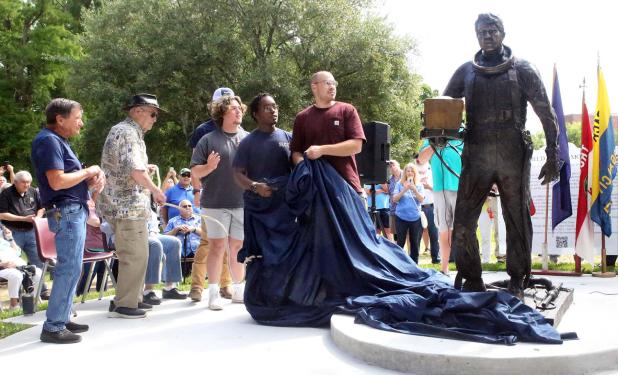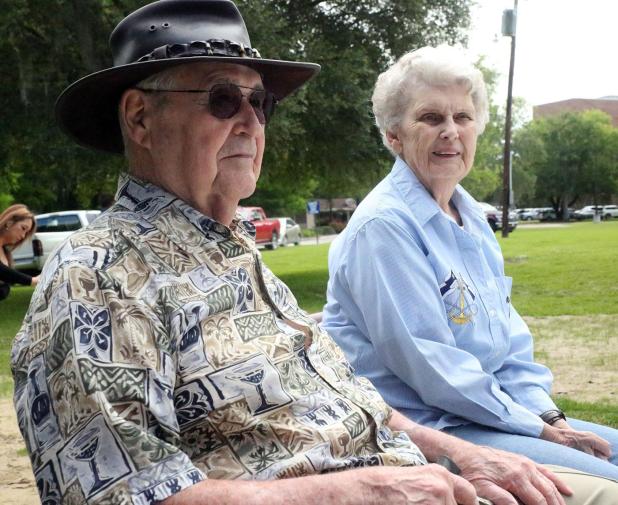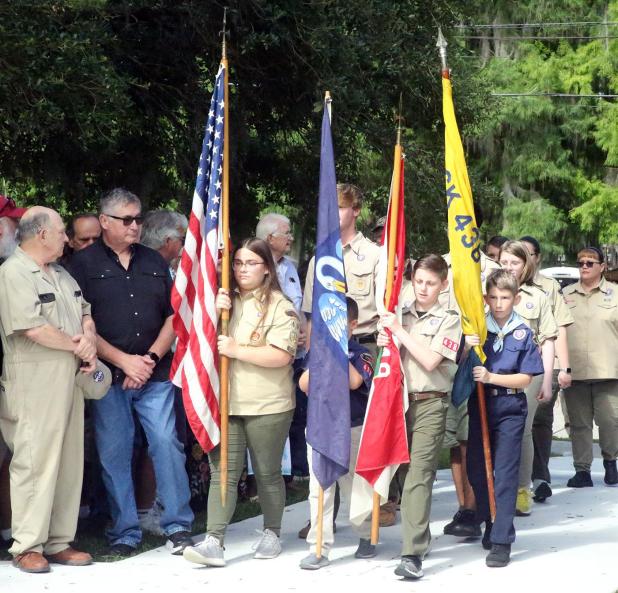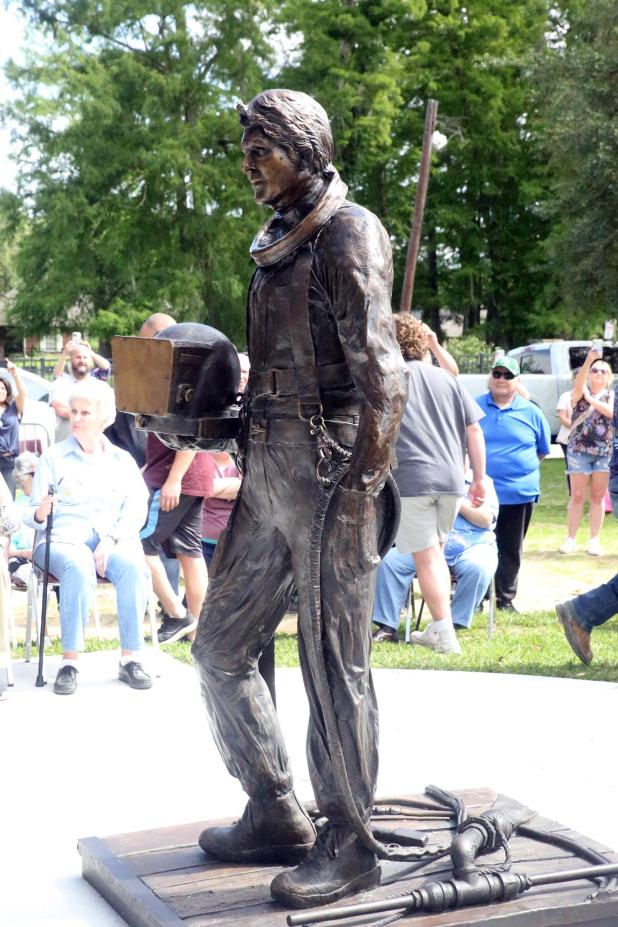
Unveiling the Oilfield Divers Monument on Saturday in Morgan City are, from left: Johnny Johnson, co-founder of the company that would become Oceaneering International; George Williams, 89, who came to Morgan City as a diver in 1957 and co-founded Continental Diving Services; and Young Memorial diving students Chandler Kesler, Trey McDowell (partially hidden), Reba Kgoadi and Cornell Myers.

George Williams, who came to Morgan City from New Jersey in 1957 to work as a diver, attends Saturday's monument unveiling with wife Susan.

Members of Scout Troop 49 of Morgan City present the flags at Saturday's monument event.

This statue is the centerpiece of the Oilfield Divers Monument.
Oilfield Divers Monument unveiling draws hundreds to Morgan City
They were young men from all over the country, spending weeks at a time away from their families to do dangerous work.
And now their lives, work and sacrifice are being remembered at the new Oilfield Divers Monument near Morgan City Municipal Auditorium, along with the role they played in the growth of the offshore energy industry.
“It’s wonderful that it’s happening,” said Mike Hughes, co-founder of the company that would become Oceaneering International. He said it’s an opportunity to remember divers who lost their lives to the work.
Oceaneering co-founder Johnny Johnson on Saturday helped unveil the life-size statue at the center of the monument, set on a concrete pad in the shape of a Mark V diving helmet. The monument, as with the Mr. Charlie rig museum and the oil derrick replica in the Brashear Avenue median, symbolizes the place the industry energy holds in Morgan City’s history.
“The evolution of the oil and gas industry and its movement offshore have been one of the fundamental forces shaping our culture, geography, society and economy during the twentieth century …,” says a sign at the monument. “The oilfield diver has been involved every step of the way.”
After true offshore platforms began producing oil in the 1940s, often staging in Morgan City, divers were needed.
George Williams, 87, arrived in Morgan City in 1957 after learning sport scuba diving in his native New Jersey. He would go on to become president of his own company, Continental Diving Services. He spent 40 years in the industry, 25 of them in the water.
Eric Hofsommer, who comes from Mountain Grove in the Missouri Ozarks, learned to dive and became a pilot after leaving the service.
“My scuba instructor told me I could make a living diving,” Hofsommer said. “I said, ‘Oh yeah?’”
He would go on to spend 27 years as a diver, working for Oceaneering, Cal Dive International and Phoenix International.
Hughes said he became a diver for two reasons.
“It was something very few people were doing,” he said “Second, it paid well. I needed the money.”
By 1964, he and Johnson started World Wide Diving, housed in a small building under the bridge in Berwick. The company later moved into a feed store in Bayou Vista.
World Wide Diving merged with companies in California and Canada to form Oceaneering in 1969.
The divers who worked for those companies performed a variety of functions. Hofsommer said the jobs included laying pipelines, connecting pipelines to platforms, inspecting platforms and doing salvage work.
“Basically,” he said, “anything you’d have to have your head underwater to do, we did it.”
And doing it could be dangerous.
Williams said the need for better safety measures is one reason he started Continental.
Divers who go deep are at risk for decompression sickness – the bends – when they return to the surface. The remedy is to put divers in an environment that matches the pressure at the depth where they’ll be working, a process called saturation.
When divers surface, they’re kept in a decompression chamber until they’re re-acclimated to the pressure at sea level. To keep from repeating the entire process with each dive, the divers are kept in a deep-dive pressure environment, even at the surface, for the duration of their work.
Hofsommer said his deepest dive was to 501 feet, which required him to spend a week in a decompression chamber.
The tables on how much saturation was needed for various depths weren’t good in the beginning, Hughes said.
“There were way too many accidents in the old days,” he said.
But “no matter what you do,” Hofsommer said, “you can’t eliminate all the risk.”
Then he said: “That’s what it makes it fun.”
The nature of the work gave divers a free-wheeling reputation that Morgan City Mayor Lee Dragna noted in his remarks at Saturday’s unveiling.
“I know a few divers who do crazy things …,” Dragna said, getting a laugh from the audience. “You do crazy things underwater, right?”
The work also seems to have created a bond among the people who do it.
Dragna said he’d attended a cocktail reception for the divers Friday night.
“They were all hugging like they hadn’t seen each other in 30 or 40 years,” Dragna said. “It was amazing.”
Developing the monument was an 18-month project of the International Petroleum Museum & Exposition – the Mr. Charlie Rig museum.
The Oilfield Divers Monument team include Rusty Wright, Bryce Merrill, Jack Vilas III, Virgil Allen and Micah Allen, who raised money for the monument.
Williams and Johnson helped unveil the statue Saturday, joined by four Young Memorial diving students: Cornell Myers, Reba Kgoadi, Chandler Kesler and Trey McDowell.
“You got to learn a lot from what [the divers] have done, the mistakes they’ve made and what they did to succeed,” Myers said.
And, he said, he heard some good drinking stories.
